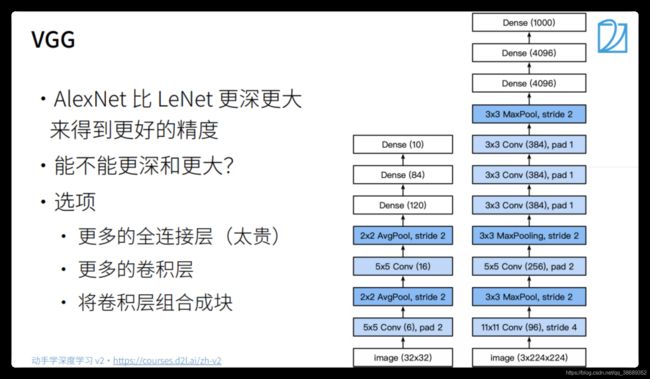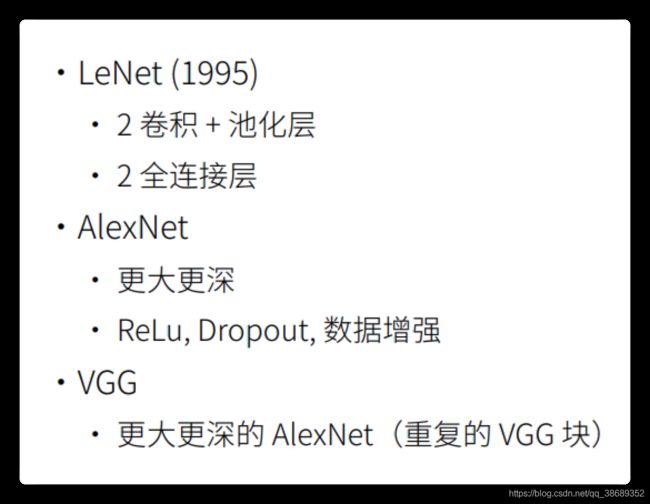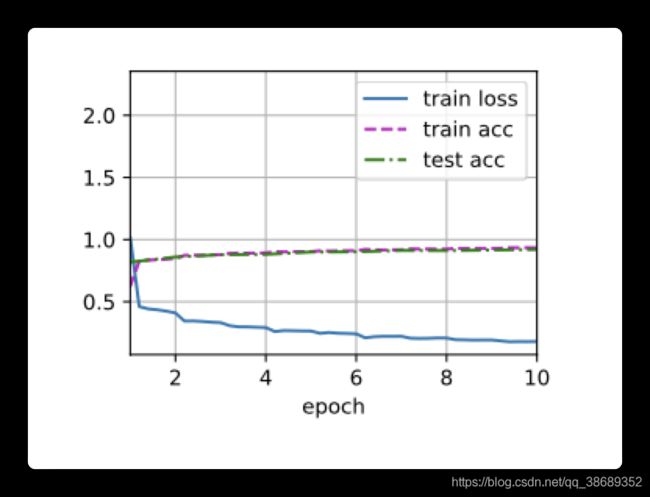动手学深度学习之经典的卷积神经网络之VGG
VGG
VGG块
-
深 vs 宽
- 5 * 5卷积
- 3 * 3卷积
- 深但窄效果更好
-
VGG块
VGG架构
进度
总结
VGG代码实现
import torch
from torch import nn
from d2l import torch as d2l
# VGG块
def vgg_block(num_convs, in_channels, out_channels):
layers = []
for _ in range(num_convs):
layers.append(nn.Conv2d(in_channels, out_channels, kernel_size=3, padding=1))
layers.append(nn.ReLU())
in_channels = out_channels
layers.append(nn.MaxPool2d(kernel_size=2, stride=2))
return nn.Sequential(*layers)
# VGG架构
conv_arch = ((1, 64), (1, 128), (2, 256), (2, 512), (2, 512))
def vgg(conv_arch):
conv_blks = []
in_channel = 1
for (num_conv, out_channels) in conv_arch:
conv_blks.append(vgg_block(num_conv, in_channel, out_channels))
in_channel = out_channels
return nn.Sequential(
*conv_blks, nn.Flatten(),
nn.Linear(out_channels * 7 * 7, 4096), nn.ReLU(),
nn.Dropout(0.5), nn.Linear(4096, 4096), nn.ReLU(),
nn.Dropout(0.5), nn.Linear(4096, 10)
)
net = vgg(conv_arch)
X = torch.randn(size=(1, 1, 224, 224))
# 从下面我们可以看到每一个VGG块的思想就是将高宽减半,通道数翻倍
for blk in net:
X = blk(X)
print(blk.__class__.__name__, 'output shape:\t', X.shape)
Sequential output shape: torch.Size([1, 64, 112, 112])
Sequential output shape: torch.Size([1, 128, 56, 56])
Sequential output shape: torch.Size([1, 256, 28, 28])
Sequential output shape: torch.Size([1, 512, 14, 14])
Sequential output shape: torch.Size([1, 512, 7, 7])
Flatten output shape: torch.Size([1, 25088])
Linear output shape: torch.Size([1, 4096])
ReLU output shape: torch.Size([1, 4096])
Dropout output shape: torch.Size([1, 4096])
Linear output shape: torch.Size([1, 4096])
ReLU output shape: torch.Size([1, 4096])
Dropout output shape: torch.Size([1, 4096])
Linear output shape: torch.Size([1, 10])
# 因为VGG-11比AlexNet计算量更大,因此我们构建一个通道数较小的网络来训练
ratio = 4
small_conv_arch = [(pair[0], pair[1] // ratio) for pair in conv_arch]
net = vgg(small_conv_arch)
lr, num_epochs, batch_size = 0.05, 10, 128
train_iter, test_iter = d2l.load_data_fashion_mnist(batch_size, resize=224)
d2l.train_ch6(net, train_iter, test_iter, num_epochs, lr, d2l.try_gpu())
使用Colab训练
import torch
import time
from torch import nn
from d2l import torch as d2l
# VGG块
def vgg_block(num_convs, in_channels, out_channels):
layers = []
for _ in range(num_convs):
layers.append(nn.Conv2d(in_channels, out_channels, kernel_size=3, padding=1))
layers.append(nn.ReLU())
in_channels = out_channels
layers.append(nn.MaxPool2d(kernel_size=2, stride=2))
return nn.Sequential(*layers)
# VGG架构
conv_arch = ((1, 64), (1, 128), (2, 256), (2, 512), (2, 512))
def vgg(conv_arch):
conv_blks = []
in_channel = 1
for (num_conv, out_channels) in conv_arch:
conv_blks.append(vgg_block(num_conv, in_channel, out_channels))
in_channel = out_channels
return nn.Sequential(
*conv_blks, nn.Flatten(),
nn.Linear(out_channels * 7 * 7, 4096), nn.ReLU(),
nn.Dropout(0.5), nn.Linear(4096, 4096), nn.ReLU(),
nn.Dropout(0.5), nn.Linear(4096, 10)
)
# 因为VGG-11比AlexNet计算量更大,因此我们构建一个通道数较小的网络来训练
ratio = 4
small_conv_arch = [(pair[0], pair[1] // ratio) for pair in conv_arch]
net = vgg(small_conv_arch)
start = time.time()
lr, num_epochs, batch_size = 0.05, 10, 128
train_iter, test_iter = d2l.load_data_fashion_mnist(batch_size, resize=224)
d2l.train_ch6(net, train_iter, test_iter, num_epochs, lr, d2l.try_gpu())
end = time.time()
print(f"time: {end - start}")
loss 0.180, train acc 0.933, test acc 0.920
388.2 examples/sec on cuda:0
time: 1701.2966752052307





